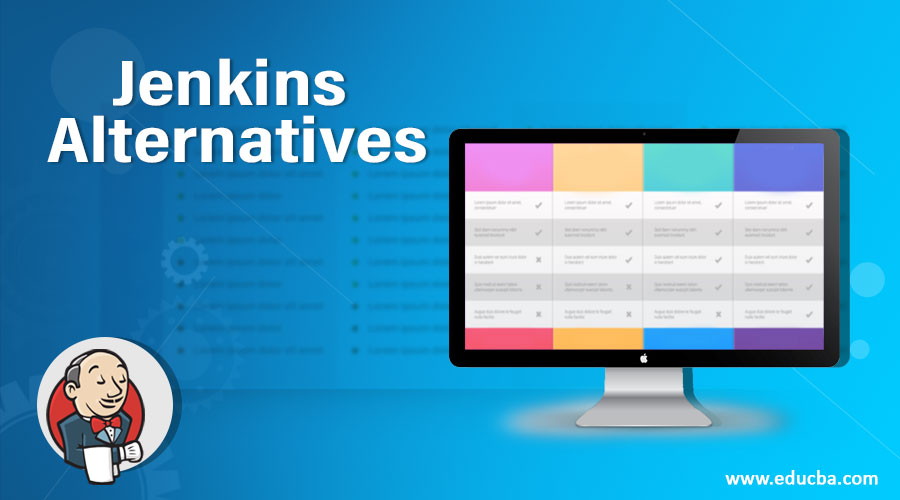Updated March 13, 2023
Introduction To Jenkins alternatives
Continues Integration is a budding practice in software systems that involves the deployment of code into source systems several instances a day in a routine manner. the build, which is performed routinely covered on each and every check-in which helps us to determine the possible errors. It definitely helps to determine errors at a comparatively faster pace and, on top of troubleshooting, make them much quicker.
This process involves a set of principles associated with it, and definitely, CI is an evolving best practice in recent years. Application deployment becomes largely possible in any state and at whatever point of time the team expects to do so.
List of Jenkins Alternatives
Below is the Different Alternatives, which are as follows:
1. Eclipse Hudson
The precursor of Jenkins, It’s been associated with the foundation of the eclipse for a long period of time until turned over by Oracle in and around a 5 year-ago period. Apache Tomcat servlet container and java are the key build components of Hudson. SCM tools supported by Hudson are as below,
- CVS
- GIT
- perforce etc
Formulated by different, including scheduling via a Cron-like mechanism, building when other builds have been completed, and by requesting a specific build URL. ultimately Oracle gave the outstanding assets of this project to the Eclipse Foundation in 2012.
2. Cruise control
It acts as an extensible framework and also a heavy power CI tool that allows building processes in a very customized manner. a large set of source control systems like vss, git, hg, clear case, file system, etc., can easily and also flexibly integrate with cruise control. From another perspective, it allows a large set of plug-in, which allows instant messaging, email access etc. these systems also support report management and also setting a large set of projects on a single server.
The three key components of these systems are as below,
- build loop: Acts as the heart of these systems, which involves notifying the listeners after triggering the build cycles. this process can be achieved through a large number of publishing techniques.
- Artifact access and results building are sophisticatedly achieved through a JSP reporting application.
- Project build statuses and visual representations of the same can be achieved through a dashboard.
3. IBM Urban code
A stable release automation software distributed from the software giant IBM. it associates two different products or components to itself.
- Urban code Deploy
- Urban code Release
- Easy rollback and consistent deployment in an automated manner.
- Notifying changes transversely through servers, components, and all tiers
- security differences and Configuration across environments
- better visibility on who has changed what and related information
- service virtualization and provisioning of software
- Easy tracking and deployment through segregating what components formulate as an application.
- Simple and easily catchy drag and drop process depicted in browser setup
- A well-established inventory that keeps hold of what is located where
- horizontal scalability and extended availability of deployment is achieved through a well-structured master/slave setup.
- pledge over the right and needed substance are imposed at an essential instance. every application and environment are tagged with a measured set of rulers.
- a large set of tools are used to make the deployment and also to set the process comparatively easier.
4. BuildKite
BuildKite is another famous integration tool in the market that is largely preferred for cross-platform build and deployment. the process of automated builds is made very much easy and pro to use with the Build kite CI. Packs with excellent customer support and integration with source controls systems like Github, harvest, etc.
The key features of Build kite are as below,
- Almost all version control systems can be easily connected to this CI
- N number of build agents can be flexibly deployed on a single standalone machine
- Slack, HipChat, Flowdock, Campfire, and many more tools can be easily integrated with the Build kit
- source code or any other passwords are never traced by build kite setup, which prompts a great extent of security from these systems
- The infrastructure of the system is also largely stable
- It is easy to use and easy set up kind of a tool
- Allows simple deployment and powerful configuration
- Also, integration with Github enterprise systems can be established.
5. GoCD
GoCD is another effective CI distributed in the market which attracts a large number of market participants towards it. It is open-source software that holds the major advantage of accessing and understanding compound workflows in an easy and subtle manner. CD pipelines can be built across an institutional interface.
- Allows ease dependency configuration and parallel execution of events
- deployment of any version of code and applications at any time period
- It uses a stream map which helps to visualize end workflows in a clear manner
- secured deployment in PROD environment
- Authorization and authentication in an easy manner
- Large and versatile number of plugins to enhance the functionality
- a very interesting and active community for help and support
- parallel execution of multiple pipelines
- sequential execution in multiple stages
- Multiple Jobs within a Stage run in parallel
- Multiple Tasks within a Job run sequentially
Recommended Articles
This has been a guide on Jenkins Alternatives. Here we have discussed the top 5 Jenkins Alternatives with their pros and cons. You may also look at the following article to learn more –



